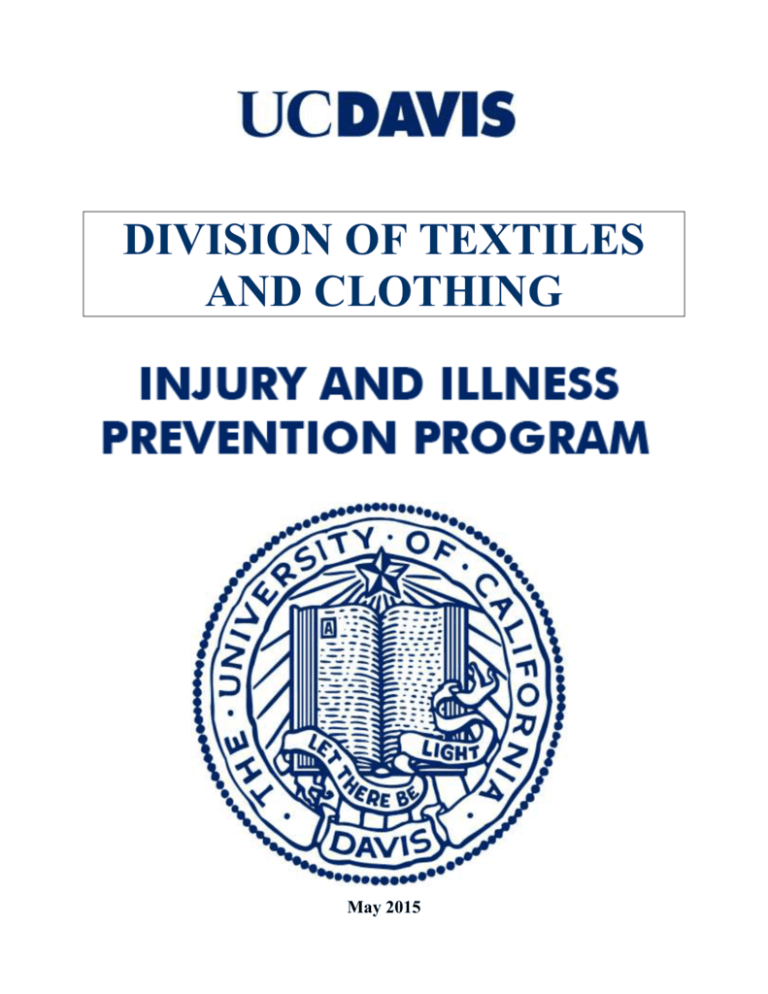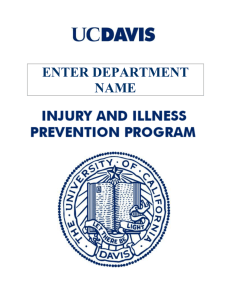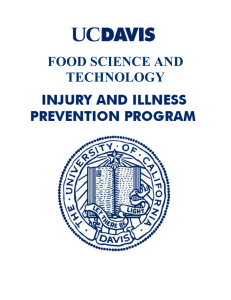TXC IIPP - UC Davis
advertisement

DIVISION OF TEXTILES AND CLOTHING May 2015 UC DAVIS DIVISION OF TEXTILES AND CLOTHING INJURY AND ILLNESS PREVENTION PROGRAM This Injury and Illness Prevention Program has been prepared by the University of California, Division of Textiles and Clothing in accordance with University Policy (UCD Policy & Procedure Manual Section 290-15: Safety Management Program) and California Code of Regulations Title 8, Section 3203 (8 CCR, Section 3203). 2 UC DAVIS DIVISION OF TEXTILES AND CLOTHING INJURY AND ILLNESS PREVENTION PROGRAM TABLE OF CONTENTS Preface Department Information I. Authorities and Responsible Parties II. System of Communications III. System for Assuring Employee Compliance with Safe Work Practices IV. Hazard Identification, Evaluation, and Inspection V. Accident Investigation VI. Hazard Correction VII. Health and Safety Training VIII. Recordkeeping and Documentation IX. Resources APPENDICES A. Hazard Alert Form B. Job Safety Analyses C. Worksite Inspection Form D. Accident Investigation Form E. Hazard Correction Form F. Safety Training Attendance Record 3 Department Information Department Name: Textiles and Clothing Department Director: You-Lo Hsieh Address: 129 Everson Hall Telephone Number: 752-6650 Buildings Occupied by Department 1. Building: Everson Hall Unit(s): Rooms in 1st and 2nd floors Contact: Phone: Lois Standley 752-6650 4 I. Authorities and Responsible Parties The authority and responsibility for the implementation and maintenance of the Injury and Illness Prevention Program (IIPP) is in accordance with University Policy (UCD Policy & Procedure Manual Section 290-15: Safety Management Program) and California Code of Regulations (8 CCR, Section 3203) and is held by the following individuals: 1. Name: You-Lo Hsieh Title: Chair/Professor Authority: Authority and responsibility for ensuring implementation of this IIPP Signature: Date: 2. Name: Gang Sun Title: Professor/ Safety Liaison Authority: Direct authority and responsibility for implementing and maintaining this IIPP Signature: Date: 3. Name: Lucy Joseph Title: Safety Coordinator Authority: Direct authority and responsibility for implementing and maintaining this IIPP Signature: Date: 5 II. System of Communications 1. Effective communications with Textiles and Clothing employees have been established using the following methods: Standard Operating Procedures Manual Material Safety Data Sheets Monthly departmental operations meetings Internal media (department intranet) EH&S Safety Nets Training videos Safety Newsletter Handouts Building Evacuation Plan E-mail Posters and warning labels Job Safety Analysis – Initial Hire Job Safety Analysis – Annual Review Other (list): Online Training - Fundamentals of Laboratory Safety, Job specific training 2. Employees are encouraged to report any potential health and safety hazard that may exist in the workplace. Hazard Alert Forms (Appendix A) are available to employees for this purpose. Forms are to be placed in the Safety Coordinator’s departmental mail box. Employees have the option to remain anonymous when making a report. 3. Employees have been advised of adherence to safe work practices and the proper use of required personal protective equipment. Conformance will be reinforced by discipline for non-compliance in accordance with University policy (UCD Procedure 62 - Personnel Policies for Staff Members, Corrective Action). 6 III. System for Assuring Employee Compliance with Safe Work Practices Employees have been advised of adherence to safe work practices and the proper use of required personal protective equipment. Conformance will be reinforced by discipline for non-compliance in accordance with University policy (UCD Procedure 62 - Personnel Policies for Staff Members, Corrective Action). The following methods are used to reinforce conformance with this program: 1. Distribution of Policies 2. Training Programs 3. Safety Performance Evaluations Performance evaluations at all levels must include an assessment of the individual's commitment to and performance of the accident prevention requirements of his/her position. The following are examples of factors considered when evaluating an employee's safety performance. Adherence to defined safety practices. Use of provided safety equipment. Reporting unsafe acts, conditions, and equipment. Offering suggestions for solutions to safety problems. Planning work to include checking safety of equipment and procedures before starting. Early reporting of illness or injury that may arise as a result of the job. Providing support to safety programs. 4. Statement of non-compliance will be placed in performance evaluations if employee neglects to follow proper safety procedures, and documented records are on file that clearly indicate training was provided for the specific topic, and that the employee understood the training and potential hazards. 5. Corrective action for non-compliance will take place when documentation exists that proper training was provided, the employee understood the training, and the employee knowingly neglected to follow proper safety procedures. Corrective action includes, but is not limited to, the following: Letter of Warning, Suspension, or Dismissal. 7 IV. Hazard Identification, Evaluation, and Inspection Job Hazard Analyses and worksite inspections have been established to identify and evaluate occupational safety and health hazards. 1. Job Safety Analysis: Job Safety Analysis (JSA) identifies and evaluates individual employee work functions, potential health or injury hazards, and specifies appropriate safe practices, personal protective equipment, and tools/equipment. JSA’s have been completed for the following job categories: A. Everson Hall Offices Office Work B. Everson Hall Laboratories Laboratory Worker Template Job Safety Analyses are located in Appendix B. Completed Job Safety Analyses are located in the IIPP Addendum Binder. 2. Worksite Inspections Worksite inspections are conducted to identify and evaluate potential hazards. Types of worksite inspections include both periodic scheduled worksite inspections as well as those required for accident investigations, injury and illness cases, and unusual occurrences. Inspections are conducted at the following worksites: 1) Location: Frequency: Responsible Person: Records Location: Everson, all lab and office locations Annual inspections Lucy Joseph 3158 RMI North Template Worksite Inspection Forms are located in Appendix C. Inspection Forms are located in the IIPP Addendum Binder. 8 Completed Worksite V. Accident Investigation 1. Textiles and Clothing employees will immediately notify their supervisor when occupationallyrelated injuries and illnesses occur, or when employees first become aware of such problems. 2. Supervisors will investigate all accidents, injuries, occupational illnesses, and near-miss incidents to identify the causal factors or attendant hazards. Appropriate repairs or procedural changes will be implemented promptly to mitigate the hazards implicated in these events. The Accident Investigation Form (Appendix D) shall be completed to record pertinent information and a copy retained to serve as proper documentation. 3. Note: Serious occupational injuries, illnesses, or exposures must be reported to Cal/OSHA by an EH&S representative within eight hours after they have become known to the supervisor. These include injuries/illnesses/exposures that cause permanent disfigurement or require hospitalization for a period in excess of 24 hours. Please refer to EH&S SafetyNet #121 for OSHA notification instructions. 9 VI. Hazard Correction Hazards discovered either as a result of a scheduled periodic inspection or during normal operations must be corrected by the supervisor in control of the work area, or by cooperation between the department in control of the work area and the supervisor of the employees working in that area. Supervisors of affected employees are expected to correct unsafe conditions as quickly as possible after discovery of a hazard, based on the severity of the hazard. Specific procedures that can be used to correct hazards include, but are not limited to, the following: • Tagging unsafe equipment “Do Not Use Until Repaired,” and providing a list of alternatives for employees to use until the equipment is repaired. • Stopping unsafe work practices and providing retraining on proper procedures before work resumes. • Reinforcing and explaining the need for proper personal protective equipment and ensuring its availability. • Barricading areas that have chemical spills or other hazards and reporting the hazardous conditions to appropriate parties. Supervisors should use the Hazard Correction Report (Appendix A) to document corrective actions, including projected and actual completion dates. If an imminent hazard exists, work in the area must cease, and the appropriate supervisor must be contacted immediately. If the hazard cannot be immediately corrected without endangering employees or property, all personnel need to leave the area except those qualified and necessary to correct the condition. These qualified individuals will be equipped with necessary safeguards before addressing the situation. 10 VII. Health and Safety Training Health and safety training, covering both general work practices and job-specific hazard training is the responsibility of the You-Lo Hsieh and immediate Supervisor(s) as applicable to the following criteria: 1. Supervisors are provided with training to become familiar with the safety and health hazards to which employees under their immediate direction and control may be exposed. 2. All new employees receive training prior to engaging in responsibilities that pose potential hazard(s). 3. All employees given new job assignments receive training on the hazards of their new responsibilities prior to actually assuming those responsibilities. 4. Training is provided whenever new substances, processes, procedures or equipment (which represent a new hazard) are introduced to the workplace. 5. Whenever the employer is made aware of a new or previously unrecognized hazard, training is provided. The Safety Training Attendance Record form is located in Appendix E. 11 VIII. Recordkeeping and Documentation Documents related to the IIPP are maintained in the 129 Everson Hall main office: . The following documents will be maintained within the IIPP Addendum Binder for at least the length of time indicated below: 1. Hazard Alert Forms and Hazard Correction Report (Appendix A forms). Retain for three (3) years. 2. Employee Job Safety Analysis forms (Appendix B form) Retain for the duration of each individual’s employment. 3. Worksite Inspection Forms (Appendix C form). Retain for three (3) years. 4. Accident Investigation Forms (Appendix D form). Retain for three (3) years. The following documents will be maintained within the IIPP Training Records Binder for at least the length of time indicated below: 1. Employee Safety Training Attendance Records (Appendix E form). Retain for three (3) years. 12 IX. Resources 1. Office of the President: University Policy on Environmental Health and Safety, 10/22/86 2. UC Davis Policy and Procedure Manual, Section 290-15, Safety Management Program 3. California Code of Regulations Title 8, Section 3203, (8CCR §3203), Injury and Illness Prevention Program 4. Personnel Policies for Staff Members, Corrective Action, UCD Procedure 62 5. University of California Policy on Management of Health, Safety and the Environment, http://www.ucop.edu/riskmgt/ehs/policy.html 6. UC Davis Environmental Health & Safety EH&S Website EH&S SafetyNets Material Safety Data Sheets 7. 13







